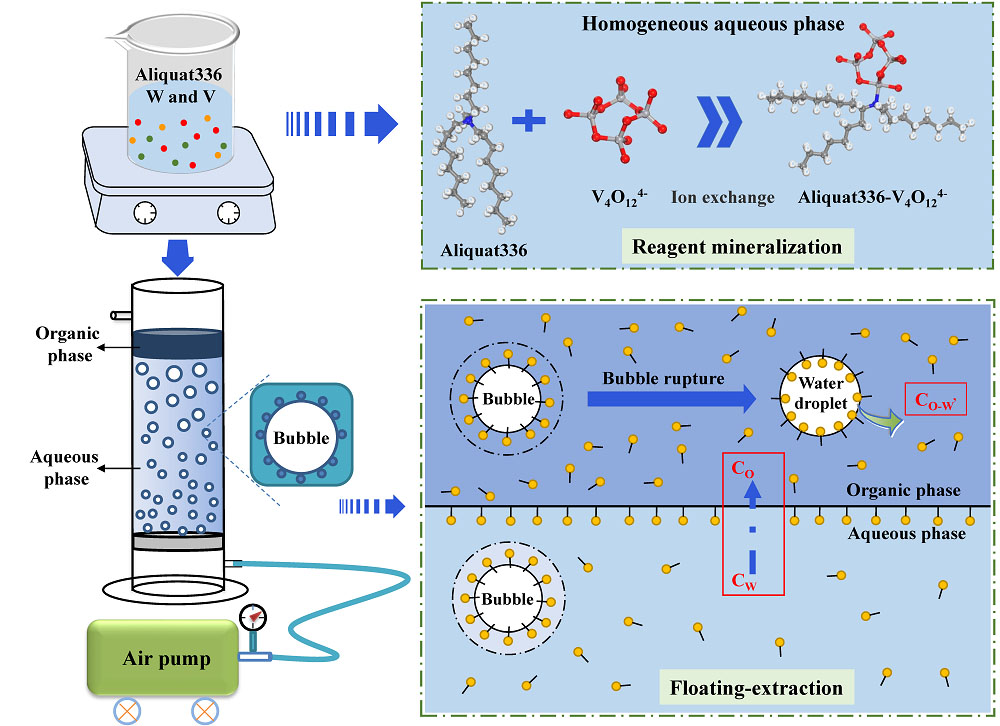1 Introduction

Fig.1 Comparison of solvent extraction and microbubble floating-extraction: (a) reaction process, and (b) mass transfer process (k1 and k2 are the mass transfer coefficients between the oil–water interface during solvent extraction; KOW′ and KOW are the separation equilibrium constants of microbubble floating-extraction and solvent extraction, respectively). |
2 Experimental
2.1 Materials
2.2 Experimental procedures
2.3 Analysis and characterizations
Tab.1 Key indexes of the microbubble floating-extraction process |
| Index | Formula | Nomenclature |
|---|---|---|
| Mineralization efficiency | , , , , and represent the concentrations of tungsten and vanadium in the feed, supernatant, raffinate, stripping solution, and floated organic phases; and are the volumes of the floated organic phase and stripping solution, respectively; DV and DW are the distribution coefficient of V and W, respectively. | |
| Flotation efficiency | ||
| Stripping efficiency | ||
| Distribution coefficient | ||
| Separation factor |
2.4 Data acquisition and error analysis
3 Results and discussion
3.1 Theoretical fundamentals for selective separation of vanadium
Tab.2 Equilibrium constants and calculation formulas of relevant ion species |
| Equation No. | Relevant reaction | lg k | Formula | Ref. |
|---|---|---|---|---|
| (1) | WO42‒ + H+ = HWO24‒ | 3.5 | [HWO4‒] = 103.5[WO42‒][H+] | [8] |
| (2) | 7WO42‒ + 8H+ = W7O246‒ + 4H2O | 65.19 | [W7O246‒] = 1065.19[WO42‒]7[H+]8 | [35] |
| (3) | 7WO42‒ + 9H+ = HW7O245‒ + 4H2O | 69.96 | [HW7O245‒] = 1069.96[WO42‒]7[H+]9 | [35] |
| (4) | 12WO42‒ + 14H+ = H2W12O4210‒ + 6H2O | 115.38 | [H2W12O4210‒] = 10115.38[WO42‒]12[H+]14 | [8] |
| (5) | VO43‒ + H+ = HVO42‒ | 13.36 | [HVO42‒] = 1013.36[VO43‒][H+] | [8] |
| (6) | 2VO43‒ + 3H+ = HV2O73‒ + H2O | 37.17 | [HV2O73‒] = 1037.17[VO43‒]2[H+]3 | [8] |
| (7) | 4VO43‒ + 8H+ = V4O124‒ + H2O | 95.11 | [V4O124‒] = 1095.11[VO43‒]4[H+]8 | [8] |
| (8) | VO43‒ + 4H+ = VO2+ + 2H2O | 28.23 | [VO2+] = 1028.23[VO43‒][H+]4 | [8] |
| (9) | 2VO43‒ + 4WO42‒ + 10H+ = V2W4O194‒ + 5H2O | 99.29 | [V2W4O194‒] = 1099.29[VO43‒]2[WO42‒]4[H+]10 | [8] |
| (10) | 3VO43‒ + 3WO42‒+ 10H+ = V3W3O195‒ + 5H2O | 105.49 | [V3W3O195‒] = 10105.49[VO43‒]3[WO42‒]3[H+]10 | [8] |
3.2 Mineralization behaviors of tungsten and vanadium

Fig.5 Effect of solution chemical conditions on the mineralization efficiency of tungsten and vanadium: (a) effect of initial pH (Aliquat336 = 1%, mineralization time = 20 min), (b) effect of mineralization time (Aliquat336 = 1%; pH = 8.67), and (c)–(f) effects of Aliquat336 dosage and initial concentrations (pH = 8.67, mineralization time = 20 min). |
3.3 Floating-extraction behaviors of tungsten and vanadium

Fig.6 Effect of flotation conditions (O/A = 1/5) on flotation efficiency of tungsten and vanadium: (a) effect of different organic solvents (flow rate = 30 mL∙min‒1, time = 30 min, 2-octanol = 10%), (b) effect of 2-octanol concentration (flow rate = 30 mL∙min‒1, time = 30 min), (c) effect of flow rate (time = 30 min, 2-octanol = 10%), and (d) effect of flotation time (flow rate = 30 mL∙min‒1, 2-octanol = 10%). |
3.4 Stripping of tungsten and vanadium from floated organic phase

Fig.7 Effect of different conditions on the stripping process of tungsten and vanadium (O/A = 1): (a) effect of stripping agents, (b) effect of concentrations of sodium hydroxide and sodium chloride, (c) effect of the proportion of sodium hydroxide (A) and sodium chloride (B), and (d) multi-stage stripping efficiency using 1.5 mol∙L‒1 sodium hydroxide + 0.25 mol∙L‒1 sodium chloride. |
3.5 Separation mechanism analysis
3.5.1 Mineralization mechanism
3.5.2 Floating-extraction mechanism

Fig.9 (a) Mass transfer process during the floating-extraction (CO is the concentration of the target substance in the organic phase at a certain time, and CW is the concentration of the target substance in the water phase at a certain time), (b) process of bubbles from oil phase to water phase, and (c) aqueous layer and droplets in floating-extraction. |
3.6 Comprehensive evaluation of microbubble floating-extraction process
Tab.3 Comparison of the present developed method with earlier reported in related literature on the separation of tungsten and vanadium |
| Method | Feed solutions | Experimental condition | Separation efficiency/% | Ref. |
|---|---|---|---|---|
| Solvent extraction | 1.0 g∙L‒1 tungsten0.1 g∙L‒1 vanadium | 0.1 mol∙L‒1 LiX63-decyl alcohol-kerosene pH = 8.0 | Tungsten extraction could be neglectedVanadium extraction of 70% | [5] |
| Solvent extraction | 52.5 g∙L‒1 tungsten6.4 g∙L‒1 vanadium | 20% Aliquat336-40% 2-octanol-sulfonated kerosene as the organic phase pH = 8.7, O/A = 2/1 | Tungsten extraction of 12.34%Vanadium extraction of 97.13% | [49] |
| Solvent extraction | 10 g∙L‒1 tungsten1.0 g∙L‒1 vanadium | 10% Aliquat336-10% 2-octanol-sulfonated kerosene as the organic phase pH = 8.6, O/A = 1/6 | Tungsten extraction of 7.74%Vanadium extraction of 92.02% | [50] |
| Microbubble floating-extraction | 10 g∙L‒1 tungsten1.0 g∙L‒1 vanadium | 1% Aliquat336 as the mineralization reagent, 10% 2-octanol-sulfonated kerosene as the organic phase, pH = 8.5, and O/A = 1/5 | Tungsten flotation efficiency of 6.11%Vanadium flotation efficiency of 95.44% | This work |








